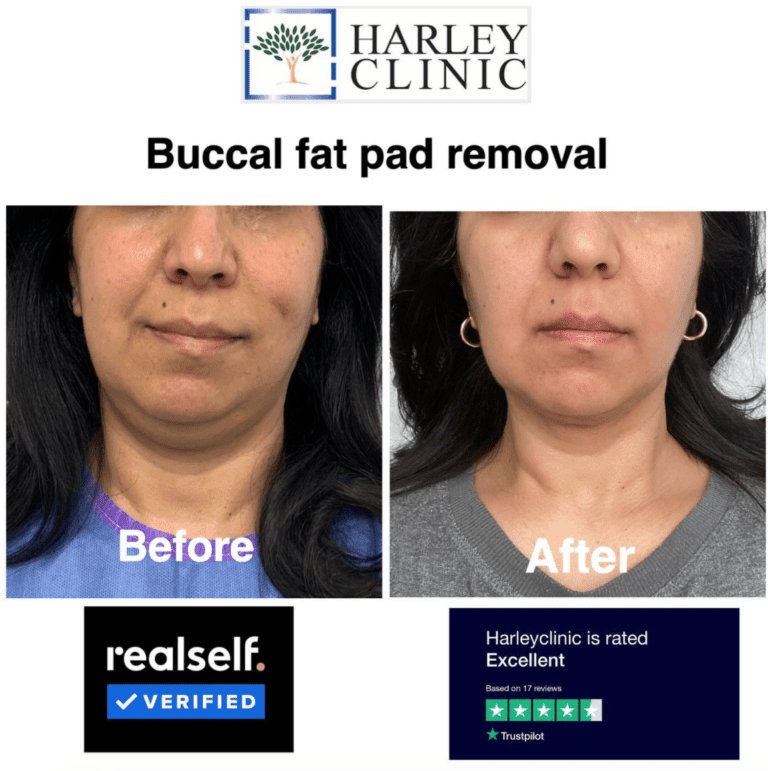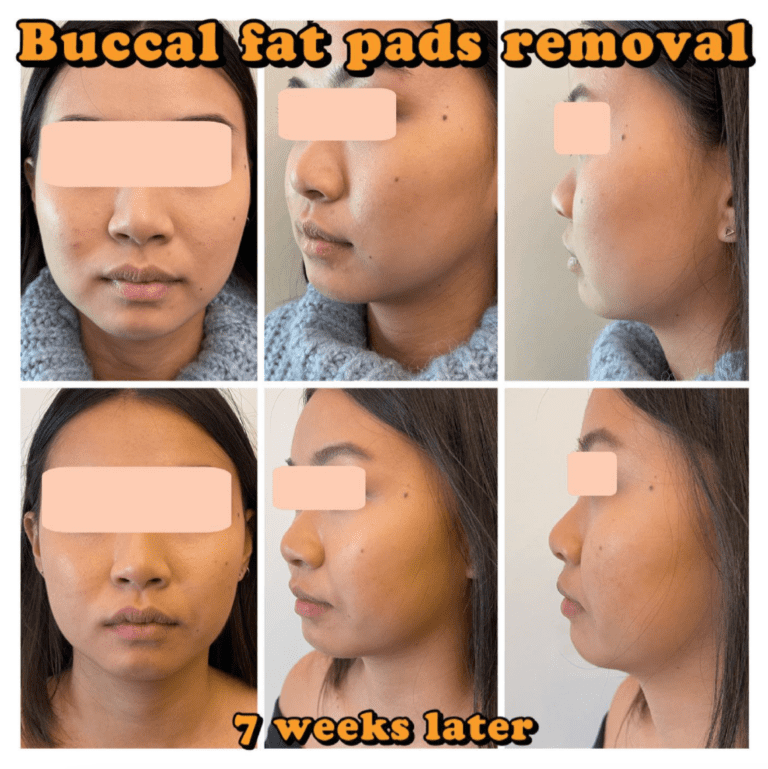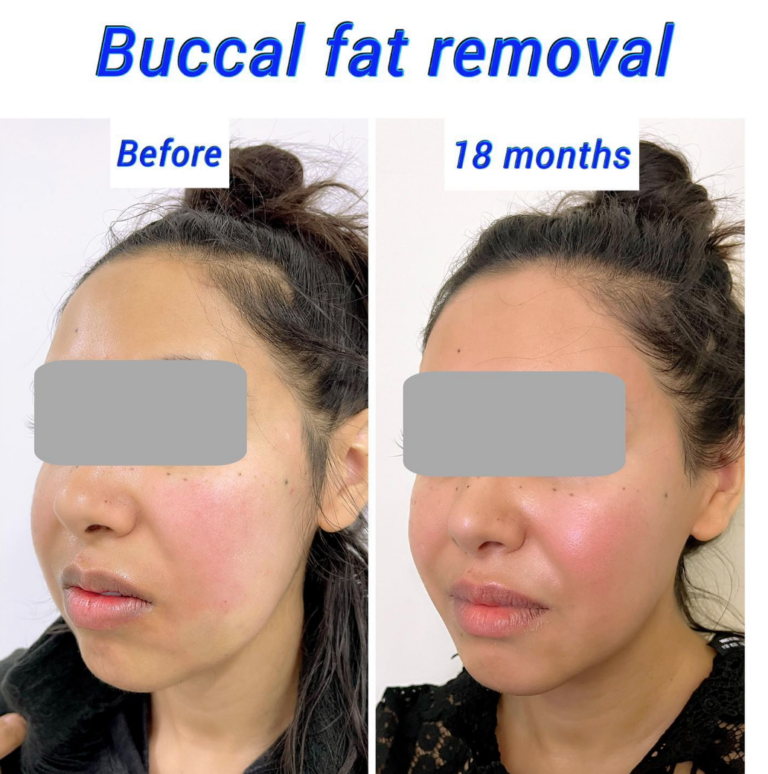What is Buccal Fat Pad Removal?
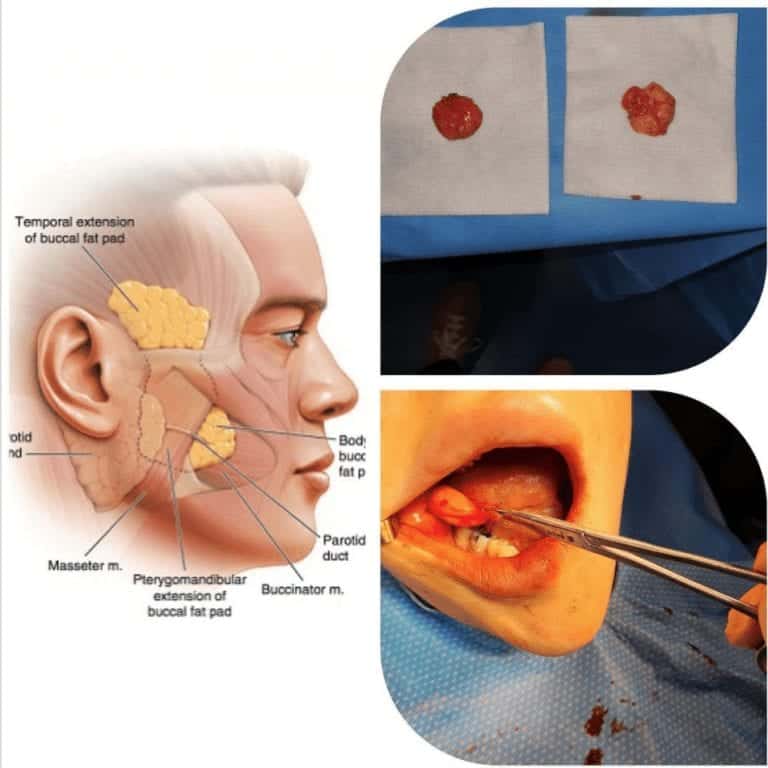
Buccal fat removal is also known as buccal fat pad excision and cheek reduction surgery. The procedure targets your buccal fat pad which is the rounded fat in the middle of the cheek. It’s in the hollow area beneath your cheekbone, between your facial muscles. Everyone has buccal fat pads, but the size can vary massively from one person to another.
Buccal Fat Pad Removal: Quick Overview
- Surgery Time: 1 hour
- Anaesthetic: Local
- Hospital Stay: Day
- Time Off Work: 1-2 Days
- Exercise: 2 Weeks
- Mobile: Immediately
- Washing: 1 day
- Sleeping Position: on you back with your head elevated for 2 weeks
- Full Recovery: 4-6 weeks
What Happens During Fat Pad Removal Surgery?
The surgery is performed from inside the mouth. This means that there are no visible scars. The procedure is relatively simple and straightforward.
Your plastic surgeon makes a small incision inside the cheek under local anaesthetic. The incisions are about half an inch long. The buccal fat pad is located between each cheekbone and the buccinator muscle (the muscle that helps with chewing). Your surgeon will then remove all or part of the buccal fat pad. Excess fat is then removed from the cheeks using a fine-tipped surgical tool to create a more defined and angular face. The incision is then closed using dissolvable sutures.
Typically, patients find that buccal fat pad removal can dramatically affect their entire facial structure, cheekbones, eyes and jawline. In a suitable candidate, patients find that the procedure results in a slimmer midface, similar to sucking in your cheeks.
After the procedure, your doctor will explain how to care for your incisions. They may also give you a special mouth rinse to facilitate healing and prevent infection. You will need to be strictly on a liquid diet for a day or two as your incision heals. Gradually you can continue adding soft foods to your diet as instructed by your doctor.
After the surgery, you can expect some swelling, bruising and numbness at the incision site. These should dissipate as the body heals. Recovery usually takes about 3 weeks, but it will take several months to see the final results.
How Long Does the Procedure Take?
One treatment session lasts between 20-45 minutes. You can achieve permanent results in less than an hour’s appointment. The procedure requires a local anaesthetic. It’s a straightforward and relatively simple procedure that can achieve dramatic results.
How Long Does it Take to Recover From Buccal Fat Pad Removal?
Buccal fat pad removal is growing in popularity for two main reasons: minimal downtime and no visible scarring. The procedure itself lasts for about one hour. You can return to daily activities within roughly 7 days of the surgery. Make sure to pencil in some downtime after your surgery to fully rest and recover. You should see the final results in 1 to 2 weeks once all the swelling has gone down.
Most patients recover from the procedure quickly and with only mild to moderate pain and swelling. Ensure you have someone to drive you home after the procedure since you will still be feeling the effects of the anaesthesia and any sedatives given. The procedure can cause a little downtime. Most people are okay to return to normal activities the day after the procedure.
Most patients report an almost pain-free recovery experience following buccal fat removal surgery. You can return to normal activities after 5 to 7 days. The results will be visible immediately after the procedure, but full results take months to show once the swelling and redness have subsided. Although many people heal well after 1 week, for some, it may take up to 4 months to fully heal. In rare cases, you may need more than one surgery to achieve the desired results.
Since the incisions are made incise the mouth, you will have to be on a soft diet and use the mouth rinse provided by the doctor to reduce the risk of infection. You should swish the mouthwash around your mouth after every meal so food particles don’t stick in the incisions.
Because of the swelling, you’ll need to regularly apply ice compresses to alleviate discomfort and reduce swelling. Buccal fat removal yields permanent results. Once the buccal fat pads are removed, they are gone for good. The buccal fat pads won’t return even if you add some weight. However, a plumper face following weight gain can mask the results of buccal fat removal surgery.

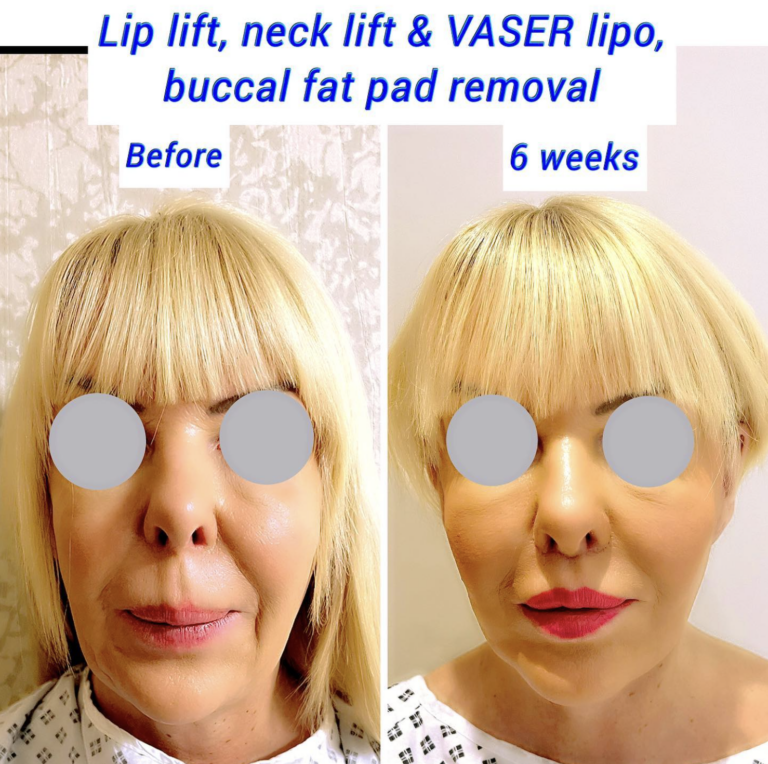
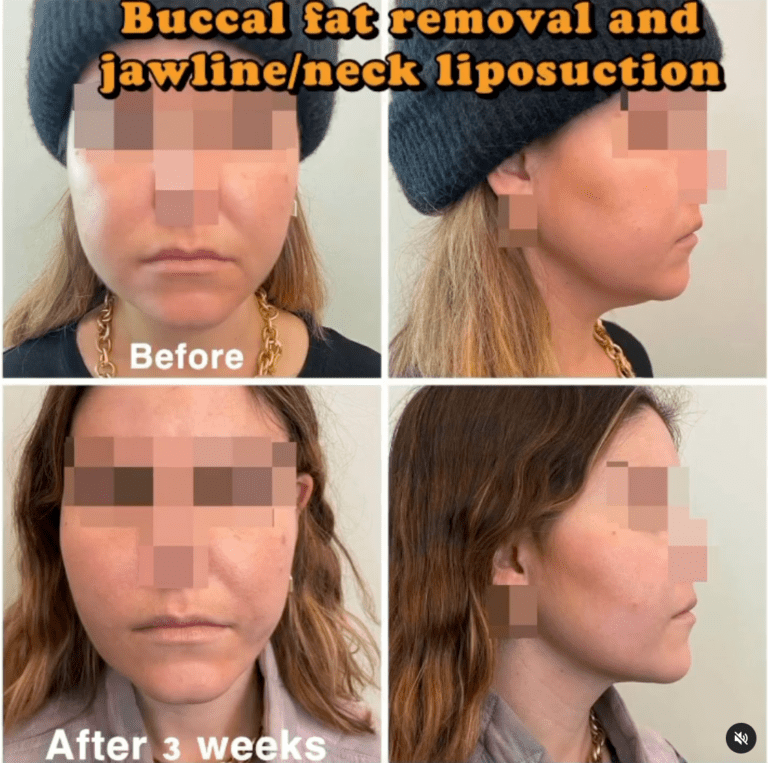
Will You Be Able to Eat and Drink After the Surgery?
After your surgery, you will be able to drink water and other clear liquids. Once you feel well enough, you can start eating soft foods like soup and eggs. After about 10 days, you should be fine to go back to your normal diet. Your surgeon will advise you on the best way to do this.
What Are the Benefits of Buccal Fat Removal?
After undergoing surgery, patients can expect a slimmer, more contoured face. The procedure not only affects how your cheeks look but the overall appearance of your face. Buccal fat removal has several benefits, including:
- Contour cheekbones
- Reduce fat volume in cheeks
- More chiselled jawline and cheeks
- Facial contour and triangulation of facial shape
- Creates a more slender and narrower facial contour
- Reduces the appearance of facial plumpness and fullness
- The cheekbone may appear slightly lifted and with more definition
- A more sculptured lower face contour
- Improved facial proportions, contour balance, plus upper and lower cheek ratio
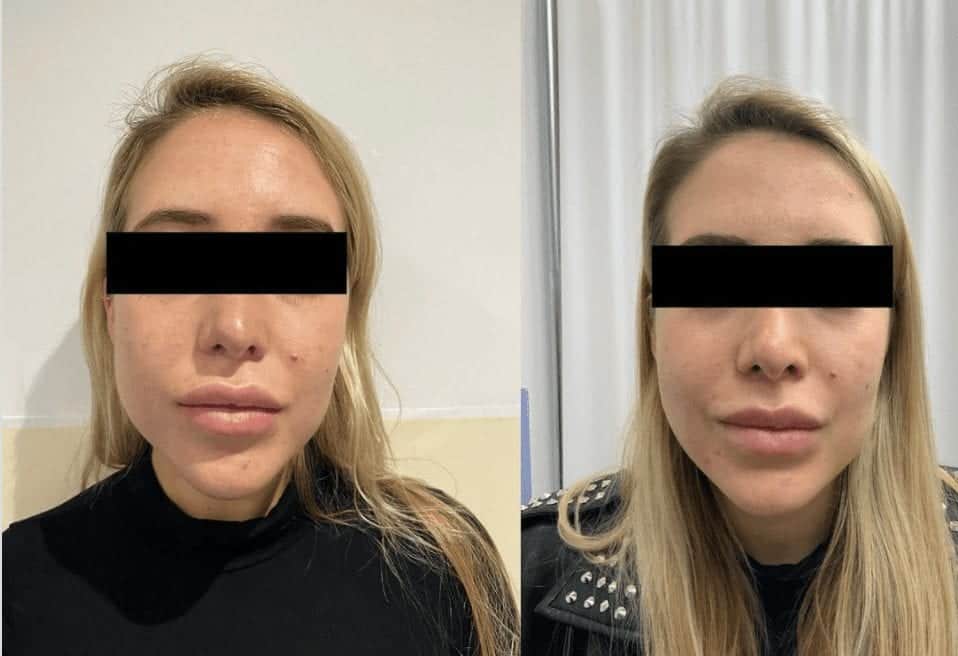
How Long Will Results Last?
The results from the procedure are permanent. Once you remove those fat pads, they are gone for good. Although your buccal fat pads won’t grow back, weight gain can mask the results of the procedure. As you age, you may see fat start to descend into the lower part of the face as well.
Your face will likely look fuller during your recovery. But after the swelling goes down, you should start to see the final result. Swelling should subside in approximately 3 weeks. It can take as long as 3 to 6 months to see the final result. During this time, your skin is settling into its new position after the fat is hollowed out.
Is Buccal Fat Pad Removal Painful?
Most patients don’t experience pain during the procedure because of the local anaesthetic. There may be some discomfort in recovery. Your mouth and jawline may feel sore, sensitive, heavy, or hard following your surgery. This should subside during recovery as you heal.
Who is Suitable for Buccal Fat Pad Removal?
Buccal fat removal is suitable for people who feel they have overly chubby cheeks. If they feel they have an overly round face, the procedure may be appropriate. The ideal candidate for buccal fat pad removal is:
- Physically healthy
- Close to ideal weight
- Non-smoker
- Has realistic expectations
Who Should Avoid Buccal Fat Pad Removal?
Some people should avoid buccal fat pad removal. During your consultation, your surgeon will go through your medical history, health assessment and speak to you in more detail about the procedure. If you have any of the following, you should avoid buccal fat pad removal:
- Serious health problems
- Overweight or unstable weight
- Thin or narrow facial structure as it can cause thin faces to look gaunt
Can You Combine Buccal Fat Pad Removal and Other Facial Surgeries?
Yes, many patients combine buccal fat pad removal with other facial surgeries. When you combine it with other surgeries, you will likely be under general anaesthetic. So, you will have varying surgery time and recovery timelines depending on the type of surgery you undergo. You can combine buccal fat pad removal with the following surgeries:
What are the Risks of Buccal Fat Removal?
There are general risks like bleeding, infection, pain, swelling, poor wound healing, poor scarring, need for further surgery, asymmetry, over-correction and under-correction. There are also specific risks like injury to a salivary duct (Stensons duct from the parotid gland) or a facial nerve branch. These risks are rare.
What to Expect at Your Buccal Fat Removal Consultation
Everyone is unique and requires an individual approach to cosmetic treatments. At Harley Clinic, you can expect a thorough consultation before your procedure. During this time, your plastic surgeon will review your medical history, carry out a complex assessment, and assess if you are the ideal candidate. We will also talk about the type of results you’re looking to achieve and the results you can expect to have. It’s an opportunity to talk through everything you need to know, possible risks, recovery time, and aftercare. It’s natural to feel a combination of anxiety and excitement before your surgery.
How to Prepare for Your Surgery
The first step to preparing for buccal fat removal surgery is to book a consultation with an experienced plastic surgeon to determine your eligibility for the procedure. During the consultation, the doctor will examine your facial structure, go through your medical history and explain the details of the procedure. You will also find out how to prepare for your surgery. This can include but is not limited to:
- No smoking 2 weeks before and after surgery
- Discussing allergies and any current medication
- Avoiding anti-inflammatory drugs
- Avoiding herbal supplements that may thin your blood
- Staying clear of alcohol for at least 2 weeks before the procedure since alcohol can increase your risk of bruising and prolonged swelling
- Discontinuing medications like Aspirin, Ibuprofen, Advil and other blood-thinning medications since they can lead to excessive bleeding and prolonged swelling
Before you go for the procedure, make sure to load up on vitamin C, ice packs and hydrogen peroxide. It’s always a good idea if someone else drives you home and stays with you, at least on the first day. During the big day, ensure you arrive clean-shaven and remove all jewellery and makeup.
Before and After Buccal Fat Pad Removal
Post-Operative Regime for Buccal Fat Pad Removal
- Mouthwash 2-3 times a day for a week
- Antibiotics may be needed
- Liquid diet on the day of surgery, followed by a soft diet and if all healed one week later at review, you can go back to a normal diet.
- Head elevation for 72 hours
- Review at 1 week to check healing, go over post-op instructions and arrange further review.
Buccal Fat Removal Surgery at the Harley Clinic
If you have round cheeks that make you self-conscious, you may be a good candidate for buccal fat removal at the Harley Clinic. Dr. Riaz Agha can help you decide if buccal fat pad removal surgery is right for you. Contact the Harley Clinic team and book a consultation today.












